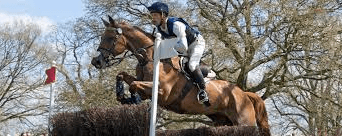What Are The Rules Of Eventing?

Eventing is a fascinating equestrian sport that combines three distinct disciplines: dressage, cross-country, and show jumping.
Each discipline has its own set of rules and requirements, creating a challenging and exciting competition for both horse and rider.
In eventing, precision, skill, courage, and elegance are essential qualities that participants must possess in order to excel.
The first discipline in eventing is dressage, often referred to as the art of precision and elegance. In this phase of the competition, riders showcase their ability to execute a series of predetermined movements with utmost control and finesse.
The judges assess the horse’s obedience, suppleness, responsiveness to the rider’s commands through subtle cues, as well as its overall harmony with the rider. Dressage not only requires technical proficiency but also demands an exceptional level of partnership between horse and rider.
Following dressage comes the thrilling cross-country phase which serves as the ultimate test of skill and courage. During this phase, competitors navigate a challenging course consisting of natural obstacles such as water jumps, ditches, banks, and solid fences over varying terrains.
Riders must demonstrate their ability to make quick decisions while maintaining balance and control at high speeds. Cross-country requires riders to have an intimate understanding of their horses’ capabilities while displaying bravery in facing obstacles that demand accuracy and athleticism.
Lastly, show jumping provides the thrilling finale to eventing competitions. This phase tests the horse’s agility over a course comprising colorful fences arranged in a specific pattern within an arena setting.
Accuracy is paramount here as riders aim to complete the course without knocking down any poles or refusing any jumps within a prescribed time limit. Show jumping showcases the horse’s athletic prowess combined with precise riding skills.
In conclusion, eventing is an exhilarating sport that encompasses three distinct disciplines – dressage, cross country, and show jumping – each presenting unique challenges for both riders and horses alike.
With precision and finesse demanded in dressage, skill and courage tested in cross country, and agility showcased in show jumping, the sport of eventing captivates the audience’s imagination and draws them into a world filled with freedom and excitement.
Dressage: The Art of Precision and Elegance
Dressage, as an essential component of eventing, embodies the pursuit of precision and elegance through a disciplined harmony between rider and horse.
Precision and grace are the key elements that define dressage, requiring riders to execute a series of intricate movements with utmost accuracy.
The journey of becoming a skilled dressage rider involves mastering these movements, which include various gaits, transitions, and figures such as circles, diagonals, and changes of direction.
It is through hours of practice and dedication that riders develop the ability to communicate subtly with their horses, guiding them effortlessly through each precise movement.
Dressage not only showcases the skill and athleticism of both horse and rider but also highlights their partnership in achieving seamless coordination and fluidity.
This art form captivates audiences who have a subconscious desire for freedom by demonstrating how discipline can lead to elegance, control can result in beauty, and precision can create harmony between two beings in motion.
Cross-Country: The Ultimate Test of Skill and Courage
Cross-Country, the thrilling phase of eventing known as the ultimate test of skill and courage, challenges riders to navigate a course filled with natural obstacles that require both precision and bravery.
Strategies for tackling challenging cross country obstacles are crucial in this phase of eventing.
Riders must carefully analyze each obstacle, determining the best approach to successfully clear them while maintaining a steady pace.
They need to assess factors such as terrain, angle of approach, and the horse’s stride length to make split-second decisions during the ride.
Additionally, rider fitness plays a vital role in cross country riding.
The intense physical demands of navigating through rough terrain and jumping over solid obstacles require riders to be strong and agile.
Fitness training is essential for building endurance, balance, and core strength needed to withstand the rigorous nature of this phase.
With thorough preparation and strategic decision-making, riders can conquer cross country obstacles with precision and confidence, showcasing their skill and courage in this exhilarating discipline of eventing.
Show Jumping: The Thrilling Finale
The thrilling finale of eventing, show jumping, brings together horse and rider to navigate a course filled with brightly colored fences that require precision and agility.
Show jumping is an exhilarating display of skill and athleticism as horse and rider soar over obstacles that can reach heights of up to 1.6 meters.
The jumps come in various shapes and sizes, including verticals, oxers, and combinations, testing the horse’s ability to quickly adjust their stride length and takeoff point.
As the riders gallop through the course, they must make split-second decisions on the best approach for each jump to clear them cleanly without knocking down any rails.
The intense focus required during these adrenaline-fueled rounds creates an electrifying atmosphere for both competitors and spectators alike.
Frequently Asked Questions
What is the minimum age requirement for participating in eventing competitions?
The participation eligibility for eventing competitions is determined by the minimum age requirement, which imposes an age restriction. This criterion ensures that individuals of a certain age possess the necessary skills and maturity to engage in such activities.
Are there different levels of difficulty in eventing, and what are they?
Eventing competitions consist of different levels of difficulty, known as levels. These levels include Beginner Novice, Novice, Training, Modified, Preliminary, Intermediate, and Advanced. Each level requires specific training techniques for eventing horses to ensure their success in the competition.
What kind of horse breeds are commonly seen in eventing competitions?
Common horse breeds in eventing include Thoroughbreds, Warmbloods, and Irish Sport Horses. Training requirements for eventing horses involve developing skills in dressage, show jumping, and cross-country to successfully navigate the challenging courses of the sport.
Can eventing be performed individually or only in teams?
Eventing can be performed both individually and in teams. Individual eventing allows for greater personal achievement, while team eventing promotes collaboration and camaraderie. Each approach has its advantages and disadvantages, catering to different preferences and goals within the sport.
Are there any specific safety measures in place to protect both the riders and horses during eventing competitions?
Safety measures during eventing competitions include mandatory safety helmets and body protectors for riders, as well as veterinary inspections to ensure the horses’ fitness. These rules aim to protect both participants and promote the welfare of horses in the sport.
Conclusion
In conclusion, eventing is a multifaceted equestrian discipline that encompasses three distinct phases: dressage, cross-country, and show jumping.
Dressage requires precision and elegance as horse and rider perform a series of prescribed movements with grace and control. It is a true art form that showcases the harmonious partnership between horse and rider.
Cross-country is the ultimate test of skill and courage as competitors navigate a challenging course filled with natural obstacles such as fences, ditches, and water jumps. This phase demands both technical expertise and bravery from horse and rider alike.
Lastly, show jumping provides the thrilling finale to an eventing competition. With its brightly colored fences set at varying heights and widths, this phase tests the athleticism, agility, and accuracy of both horse and rider.
Overall, eventing requires a well-rounded combination of physical fitness, technical competence, mental fortitude, trust between horse and rider, as well as effective communication. It exemplifies the beauty of horsemanship while pushing competitors to their limits.
Eventing truly embodies the essence of equestrian sport – where strength meets grace in perfect harmony.



